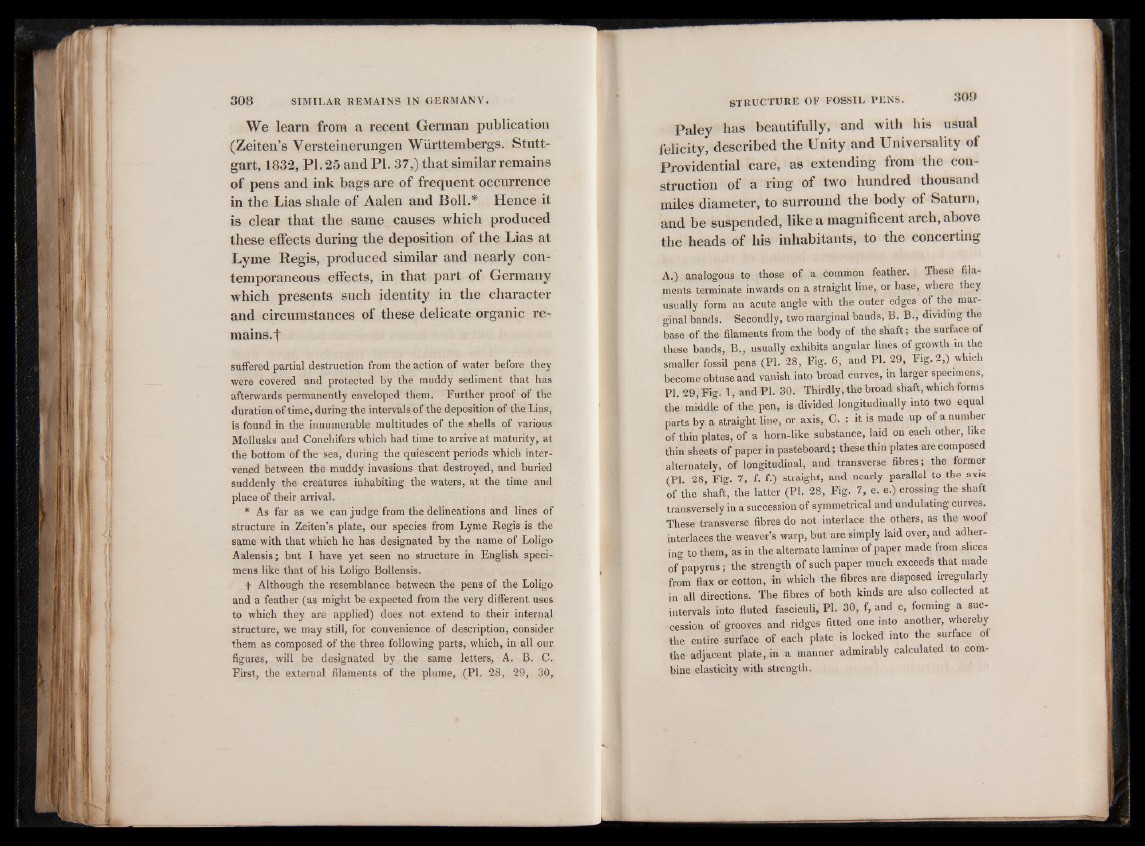
We learn from a recent German publication
(Zeiten’s Versteinerungen Württembergs. Stuttgart,
1832, PI. 25 and PI. 37,) that similar remains
of pens and ink bags are of frequent occurrence
in the Lias shale of Aalen and Boll.* Hence it
is clear that the same causes which produced
these effects during the deposition of the Lias at
Lyme Regis, produced similar and nearly contemporaneous
effects, in that part of Germany
which presents such identity in the character
and circumstances of these delicate organic remains.!
suffered partial destruction from the action of water before they
were covered and protected by the muddy sediment that has
afterwards permanently enveloped them. Further proof of the
duration of time, during the intervals of the deposition of the Lias,
is found in the innumerable multitudes of the shells of various
Mollusks and Conchifers which had time to arrive at maturity, at
the bottom of the sea, during the quiescent periods which intervened
between the muddy invasions that destroyed, and buried
suddenly the creatures inhabiting the waters, at the time and
place of their arrival.
* As far as we can judge from the delineations and lines of
structure in Zeiten’s plate, our species from Lyme Regis is the
same with that which he has designated by the name of Loligo
Aalensis; but I have yet seen no structure in English specimens
like that of his Loligo Bollensis.
f Although the resemblance between the pens of the Loligo
and a feather (as might be expected from the very different uses
to which they are applied) does not extend to their internal
structure, we may still, for convenience of description, consider
them as composed of the three following parts, which, in all our
figures, will be designated by. the same letters, A. B. C.
First, the external filaments of the plume, (PL 28, 29, 30,.
Paley has beautifully, and with his usual
felicity, described the Unity and Universality of
Providential care, as extending from the construction
of a ring of two hundred thousand
miles diameter, to surround the body of Saturn,
and be suspended, like a magnificent arch, above
the heads of his inhabitants, to the concerting
A.) analogous to those of a common feather. These filaments
terminate inwards on a straight line, or base, where they
usually form an acute angle with the outer edges of the marginal
bands. Secondly, two marginal bands, B. B., dividing the
base of the filaments from the body of the shaft; the surface of
these bands, B., usually exhibits angular lines of growth in the
smaller fossil pens (PI. 28, Fig. 6, and Pl. 29, Fig. 2,) which
become obtuse and vanish into broad curves, in larger specimens,
PI. 29, Fig. I , and PI. 30. Thirdly, the broad shaft, which forms
the middle of the pen, is divided longitudinally into two equal
parts by a straight line, or axis, C. : it is made up of a number
of thin plates, of a horn-like substance, laid on each other, like
thin sheets of paper in pasteboard; these thin plates are composed
alternately, of longitudinal, and transverse fibres; the former
(PI. 28, Fig. 7, f. f.) straight, and nearly parallel to the axis
of the shaft, the latter (PI. 28, Fig. 7, e. e.) crossing the shaft
transversely in a succession of symmetrical and undulating curves.
These transverse fibres do not interlace the others, as the woof
interlaces the weaver’s warp, but are simply laid over, and adhering
to them, as in the alternate laminse of paper made from slices
of papyrus; the strength of such paper much exceeds that made
from flax or cotton, in which the fibres are disposed irregularly
in all directions. The fibres of both kinds are also collected at
intervals into fluted fasciculi, PL 30, f, and e, forming a succession
of grooves and ridges fitted one into another, whereby
the entire surface of each plate is locked into the surface o
the adjacent plate, in a manner admirably calculated to combine
elasticity with strength.